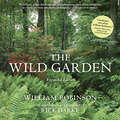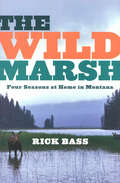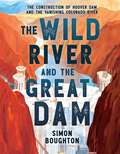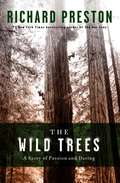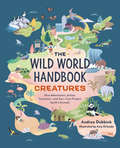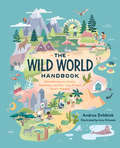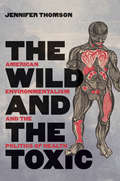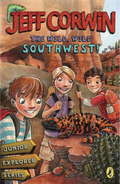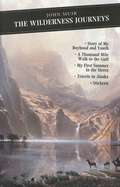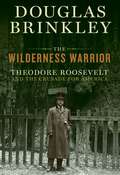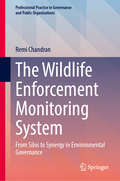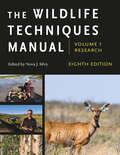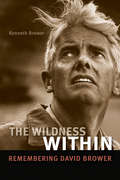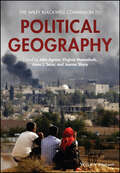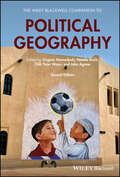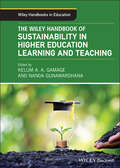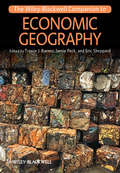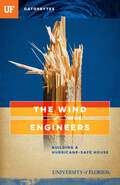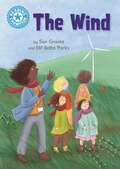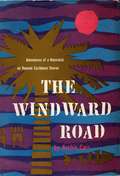- Table View
- List View
The Wild Garden: Expanded Edition
by William Robinson Rick DarkeFirst published in 1870, The Wild Garden challenged the prevailing garden style of the day and advocated a naturalistic style, in which hardy plants, both native and exotic, are arranged in groupings that mimic wild landscapes. Thanks to Robinson’s passionate advocacy, the naturalistic style triumphed, and Robinson's urgent message continues to resonate today. For this newly designed edition, Rick Darke has written an introductory essay that not only underscores Robinson’s importance in the evolution of garden design and ecology, but also explains his relevance for today’s gardeners, designers, and landscape professionals. The book contains over 100 stunning photographs taken by Darke, including images of Gravetye and of modern “wild” gardens.
The Wild Marsh: Four Seasons at Home in Montana
by Rick BassThe Wild Marsh is Rick Bass's most mature, full account of life in the Yaak and a crowning achievement in his celebrated career. It begins with his family settling in for the long Montana winter, and captures all the subtle harbingers of change that mark each passing month -- the initial cruel teasing of spring, the splendor and fecundity of summer, and the bittersweet memories evoked by fall. It is full of rich observation about what it takes to live in the valley -- ruggedness, improvisation and, of course, duct tape. The Wild Marsh is also tremendously poignant, especially when Bass reflects on what it means for his young daughters to grow up surrounded by the strangeness and wonder of nature. He shares with them the Yaak's little secrets -- where the huckleberries are best in a dry year, where to find a grizzly's claw marks in an old cedar -- and discovers that passing on this intimate local knowledge, the knowledge of home, is a kind of rare and valuable love. Bass emerges not just as a writer but as a father, a neighbor, and a gifted observer, uniquely able to bring us close to the drama and sanctity of small things, ensuring that though the wilderness is increasingly at risk, the voice of the wilderness will not disappear.
The Wild River and the Great Dam: The Construction of Hoover Dam and the Vanishing Colorado River
by Simon BoughtonDiscover the complicated history behind the construction of Hoover Dam—one of the country’s most recognizable and far-reaching landmarks—and its lasting political and environmental effects on the Colorado River and the American West. <P><P> At the time of its completion in 1936, Hoover Dam was the biggest dam in the world and the largest feat of architecture and engineering in the country—a statement of national ambition and technical achievement. It turned the wild Colorado River into a tame and securely managed water source, transforming millions of acres of desert into farmland while also providing water and power to the fast-growing population of the Southwest. The concrete monolith quickly became a symbol of American ingenuity; however, its history is laden with contradiction. It provided work for thousands, but it was a dangerous project that exploited desperate workers during the Depression. It helped secure the settlement and economies of the Southwest, but at the expense of Indigenous peoples and the environment; and it created a dependency on the Colorado River’s water, which is under threat from overuse and climate change. <P><P> Weaving together elements of engineering, geography, and political and socioeconomic history, and drawing heavily from unpublished oral histories taken from dam workers and their families, Simon Boughton’s thoughtful and compelling debut—featuring historical photographs throughout—follows the construction and impact of Hoover Dam, and how its promise of abundance ultimately created a river in crisis today.
The Wild Trees: A Story of Passion and Daring
by Richard PrestonHidden away in foggy, uncharted rain forest valleys in Northern California are the largest and tallest organisms the world has ever sustained–the coast redwood trees, Sequoia sempervirens. Ninety-six percent of the ancient redwood forests have been destroyed by logging, but the untouched fragments that remain are among the great wonders of nature. The biggest redwoods have trunks up to thirty feet wide and can rise more than thirty-five stories above the ground, forming cathedral-like structures in the air. Until recently, redwoods were thought to be virtually impossible to ascend, and the canopy at the tops of these majestic trees was undiscovered. In The Wild Trees, Richard Preston unfolds the spellbinding story of Steve Sillett, Marie Antoine, and the tiny group of daring botanists and amateur naturalists that found a lost world above California, a world that is dangerous, hauntingly beautiful, and unexplored. The canopy voyagers are young–just college students when they start their quest–and they share a passion for these trees, persevering in spite of sometimes crushing personal obstacles and failings. They take big risks, they ignore common wisdom (such as the notion that there’s nothing left to discover in North America), and they even make love in hammocks stretched between branches three hundred feet in the air. The deep redwood canopy is a vertical Eden filled with mosses, lichens, spotted salamanders, hanging gardens of ferns, and thickets of huckleberry bushes, all growing out of massive trunk systems that have fused and formed flying buttresses, sometimes carved into blackened chambers, hollowed out by fire, called “fire caves.” Thick layers of soil sitting on limbs harbor animal and plant life that is unknown to science. Humans move through the deep canopy suspended on ropes, far out of sight of the ground, knowing that the price of a small mistake can be a plunge to one’s death. Preston’s account of this amazing world, by turns terrifying, moving, and fascinating, is an adventure story told in novelistic detail by a master of nonfiction narrative. The author shares his protagonists’ passion for tall trees, and he mastered the techniques of tall-tree climbing to tell the story in The Wild Trees–-the story of the fate of the world’s most splendid forests and of the imperiled biosphere itself.
The Wild Trees: A Story of Passion and Daring
by Richard PrestonHidden away in foggy, uncharted rain forest valleys in Northern California are the largest and tallest organisms the world has ever sustained-the coast redwood trees, Sequoia sempervirens. Ninety-six percent of the ancient redwood forests have been destroyed by logging, but the untouched fragments that remain are among the great wonders of nature. The biggest redwoods have trunks up to thirty feet wide and can rise more than thirty-five stories above the ground, forming cathedral-like structures in the air. Until recently, redwoods were thought to be virtually impossible to ascend, and the canopy at the tops of these majestic trees was undiscovered. In The Wild Trees, Richard Preston unfolds the spellbinding story of Steve Sillett, Marie Antoine, and the tiny group of daring botanists and amateur naturalists that found a lost world above California, a world that is dangerous, hauntingly beautiful, and unexplored. The canopy voyagers are young-just college students when they start their quest-and they share a passion for these trees, persevering in spite of sometimes crushing personal obstacles and failings. They take big risks, they ignore common wisdom (such as the notion that there's nothing left to discover in North America), and they even make love in hammocks stretched between branches three hundred feet in the air.The deep redwood canopy is a vertical Eden filled with mosses, lichens, spotted salamanders, hanging gardens of ferns, and thickets of huckleberry bushes, all growing out of massive trunk systems that have fused and formed flying buttresses, sometimes carved into blackened chambers, hollowed out by fire, called "fire caves." Thick layers of soil sitting on limbs harbor animal and plant life that is unknown to science. Humans move through the deep canopy suspended on ropes, far out of sight of the ground, knowing that the price of a small mistake can be a plunge to one's death.Preston's account of this amazing world, by turns terrifying, moving, and fascinating, is an adventure story told in novelistic detail by a master of nonfiction narrative. The author shares his protagonists' passion for tall trees, and he mastered the techniques of tall-tree climbing to tell the story in The Wild Trees-the story of the fate of the world's most splendid forests and of the imperiled biosphere itself.From the Hardcover edition.
The Wild Trees: A Story of Passion and Daring
by Richard PrestonHidden away in foggy, uncharted rain forest valleys in Northern California are the largest and tallest organisms the world has ever sustained-the coast redwood trees, Sequoia sempervirens. Ninety-six percent of the ancient redwood forests have been destroyed by logging, but the untouched fragments that remain are among the great wonders of nature. The biggest redwoods have trunks up to thirty feet wide and can rise more than thirty-five stories above the ground, forming cathedral-like structures in the air. Until recently, redwoods were thought to be virtually impossible to ascend, and the canopy at the tops of these majestic trees was undiscovered. In The Wild Trees, Richard Preston unfolds the spellbinding story of Steve Sillett, Marie Antoine, and the tiny group of daring botanists and amateur naturalists that found a lost world above California, a world that is dangerous, hauntingly beautiful, and unexplored. The canopy voyagers are young-just college students when they start their quest-and they share a passion for these trees, persevering in spite of sometimes crushing personal obstacles and failings. They take big risks, they ignore common wisdom (such as the notion that there's nothing left to discover in North America), and they even make love in hammocks stretched between branches three hundred feet in the air.The deep redwood canopy is a vertical Eden filled with mosses, lichens, spotted salamanders, hanging gardens of ferns, and thickets of huckleberry bushes, all growing out of massive trunk systems that have fused and formed flying buttresses, sometimes carved into blackened chambers, hollowed out by fire, called "fire caves." Thick layers of soil sitting on limbs harbor animal and plant life that is unknown to science. Humans move through the deep canopy suspended on ropes, far out of sight of the ground, knowing that the price of a small mistake can be a plunge to one's death.Preston's account of this amazing world, by turns terrifying, moving, and fascinating, is an adventure story told in novelistic detail by a master of nonfiction narrative. The author shares his protagonists' passion for tall trees, and he mastered the techniques of tall-tree climbing to tell the story in The Wild Trees-the story of the fate of the world's most splendid forests and of the imperiled biosphere itself.From the Hardcover edition.
The Wild World Handbook: Creatures (The Wild World Handbook #2)
by Andrea DebbinkPacked with real-life tales of adventure, breathtaking illustrations, and practical tools, this handbook is an inspiring guide for the next generation of climate activists, conservationists, and nature lovers.We share this incredible planet we call home with countless living creatures, from butterflies and falcons to koalas and dolphins. And just like us, animals everywhere are faced with the growing threat of climate change. Featuring seven categories of creatures, this handbook offers a roadmap for change and an invitation to explore the outdoors with fascinating facts, hope-filled stories, and hands-on STEAM activities. Each chapter highlights the biographies of scientists, artists, and adventurers from diverse backgrounds who have used their passion and skills to become courageous advocates for animals around the world. The second book in a middle-grade series for young activists and conservationists, The Wild World Handbook: Creatures empowers readers to appreciate and protect Earth&’s wildlife.Inside you will find: • Seven incredible categories of creatures • Fourteen inspiring biographies • Seven kid-friendly DIY activities • Seven fun field trips • And much more!
The Wild World Handbook: Habitats (The Wild World Handbook #1)
by Andrea DebbinkPacked with real-life tales of adventure, breathtaking illustrations, and practical tips, this handbook is an inspiring guide for the next generation of climate activists, conservationists, and nature lovers.The wonder of the natural world surrounds us—from the Amazon rainforest to the snowy peaks of Mount Everest to the green spaces in big cities. And as the threat of climate change grows, it&’s more important than ever to show appreciation for our planet by taking action.The first book in a middle grade series for young environmental activists and nature lovers, The Wild World Handbook offers a roadmap for change and an invitation to explore the outdoors, alongside surprising facts and hands-on STEAM activities. Featuring nine habitats from around the globe, each section includes diverse biographies of outdoor adventurers, scientists, and artists who used their passion and skills to become bold allies for Earth&’s natural diversity and resiliency.Inside you will find: • Nine Amazing Habitats • Eighteen Inspiring Biographies • Nine Kid-Friendly DIY Activities • Nine Fun Field Trips • And much more! It&’s up to us to protect this beautiful, awe-inspiring planet we call home!
The Wild and the Toxic: American Environmentalism and the Politics of Health
by Jennifer ThomsonHealth figures centrally in late twentieth-century environmental activism. There are many competing claims about the health of ecosystems, the health of the planet, and the health of humans, yet there is little agreement among the likes of D.C. lobbyists, grassroots organizers, eco-anarchist collectives, and science-based advocacy organizations about whose health matters most, or what health even means. In this book, Jennifer Thomson untangles the complex web of political, social, and intellectual developments that gave rise to the multiplicity of claims and concerns about environmental health. Thomson traces four strands of activism from the 1970s to the present: the environmental lobby, environmental justice groups, radical environmentalism and bioregionalism, and climate justice activism. By focusing on health, environmentalists were empowered to intervene in the rise of neoliberalism, the erosion of the regulatory state, and the decimation of mass-based progressive politics. Yet, as this book reveals, an individualist definition of health ultimately won out over more communal understandings. Considering this turn from collective solidarity toward individual health helps explain the near paralysis of collective action in the face of planetary disaster.
The Wild, Wild Southwest!
by Jeff CorwinIt's a fascinating adventure with nature - this time in New Mexico! Budding naturalists Lucy, Benjamin, and Gabe are back and camping in the Gila National Forest in New Mexico! Readers can join the fun as these kids explore the diverse desert ecosystem. This is the third book in Jeff Corwin's young middlegrade fiction series, which shows kids that no matter where you live, you can have fun discovering the plants, animals, and natural life around you. .
The Wilderness Journeys: My Boyhood And Youth - First Summer In The Sierra - 1000 Mile Walk - Stickeen - Travels In Alaska (Canongate Classics #Vol. 67)
by John MuirFive works by the naturalist considered the father of the modern conservation movement, documenting the unspoiled beauty of nineteenth-century America. When we try to pick out anything by itself, we find it hitched to everything else in the universe. —John Muir, My First Summer in the Sierra The name of John Muir has come to stand for the protection of wild land and wilderness in both America and Britain. Born in Scotland in 1838, Muir is famed as the father of American conservation and the founder of the Sierra Club. This collection, including the rarely seen Stickeen, presents the finest of Muir&’s writings, painting a portrait of a man whose generosity, passion, and vision are an inspiration to this day. Combining acute observation, amusing anecdotes, and a sense of inner discovery, Muir&’s writings of his travels though some of the greatest landscapes on Earth, including the Carolinas, Florida, Alaska, and those lands that were to become the great National Parks of Yosemite and the Sierra Valley, raise an awareness of nature to a spiritual dimension. Includes an introduction by Graham White
The Wilderness Warrior: Theodore Roosevelt and the Crusade for America
by Douglas Brinkley<P>In this groundbreaking epic biography, Douglas Brinkley draws on never-before-published materials to examine the life and achievements of our "naturalist president." <P>By setting aside more than 230 million acres of wild America for posterity between 1901 and 1909, Theodore Roosevelt made conservation a universal endeavor. This crusade for the American wilderness was perhaps the greatest U.S. presidential initiative between the Civil War and World War I. Roosevelt's most important legacies led to the creation of the U.S. Fish and Wildlife Service and passage of the Antiquities Act in 1906. His executive orders saved such treasures as Devils Tower, the Grand Canyon, and the Petrified Forest. <P>Tracing the role that nature played in Roosevelt's storied career, Brinkley brilliantly analyzes the influence that the works of John James Audubon and Charles Darwin had on the young man who would become our twenty-sixth president. With descriptive flair, the author illuminates Roosevelt's bird watching in the Adirondacks, wildlife obsession in Yellowstone, hikes in the Blue Ridge Mountains, ranching in the Dakota Territory, hunting in the Big Horn Mountains, and outdoor romps through Idaho and Wyoming. <P>He also profiles Roosevelt's incredible circle of naturalist friends, including the Catskills poet John Burroughs, Boone and Crockett Club cofounder George Bird Grinnell, forestry zealot Gifford Pinchot, buffalo breeder William Hornaday, Sierra Club founder John Muir, U.S. Biological Survey wizard C. Hart Merriam, Oregon Audubon Society founder William L. Finley, and pelican protector Paul Kroegel, among many others. He brings to life hilarious anecdotes of wild-pig hunting in Texas and badger saving in Kansas, wolf catching in Oklahoma and grouse flushing in Iowa. Even the story of the teddy bear gets its definitive treatment. <P>Destined to become a classic, this extraordinary and timeless biography offers a penetrating and colorful look at Roosevelt's naturalist achievements, a legacy now more important than ever. Raising a Paul Revere-like alarm about American wildlife in peril--including buffalo, manatees, antelope, egrets, and elk--Roosevelt saved entire species from probable extinction. <P>As we face the problems of global warming, overpopulation, and sustainable land management, this imposing leader's stout resolution to protect our environment is an inspiration and a contemporary call to arms for us all. <P><b>A New York Times Bestseller</b>
The Wildlife Detectives: How Forensic Scientists Fight Crimes Against Nature
by Donna M. Jackson Wendy Shattil Bob RozinskiSlaughtering elephants for their ivory; shooting bears for their gall bladders; capturing sea turtles for soup. In the name of vanity, fashion, and greed, man stalks and kills wild animals -- and gets away with it, even when it is clearly against the law. But now scientists have a way to catch and convict poachers. In a laboratory in Ashland, Oregon, they analyze clues to link suspects to crimes. In words and pictures, this book tells a poignant story and reveals how science can indeed save the day.
The Wildlife Enforcement Monitoring System: From Silos to Synergy in Environmental Governance (Professional Practice in Governance and Public Organizations)
by Remi ChandranIn The Wildlife Enforcement Monitoring System, Remi Chandran chronicles a twenty-year journey to develop an innovative tool that enhances wildlife law enforcement information sharing through mapping technology. The book examines the intrinsic challenges of data sharing, which is shackled by conflicting regulations, ideologies, and institutional barriers. By exploring the changes in the wildlife-trade policy system and the evolving roles of key actors, Chandran reveals how these shifts transformed the Wildlife Enforcement Monitoring System (WEMS). The novel WEMS initiative redefined data-exchange practices and shaped the way for platforms like the Digital Public Infrastructure to tackle humanature conflicts. More than a technical achievement, this is a story of collaboration, resilience, and shared knowledge.
The Wildlife Techniques Manual: Volume 1: Research. Volume 2: Management.
by Nova J. SilvyThe #1 selling wildlife management book for 40 years, now updated for the next generation of professionals and students.Since its original publication in 1960, The Wildlife Techniques Manual has remained the cornerstone text for the professional wildlife biologist. Now fully revised and updated, this eighth edition promises to be the most comprehensive resource on wildlife biology, conservation, and management for years to come.Superbly edited by Nova J. Silvy and published in association with The Wildlife Society, the 50 authoritative chapters included in this work provide a full synthesis of methods used in the field and laboratory. Chapter authors, all leading wildlife professionals, explain and critique traditional and new methodologies and offer thorough discussions of a wide range of relevant topics. To effectively incorporate the explosion of new information in the wildlife profession, this latest edition is logically organized into a 2-volume set: Volume 1 is devoted to research techniques and Volume 2 focuses on pragmatic management methodologies.Volume 1 describes research design and proper analytic methods prior to conducting research, as well as methods and considerations for capturing and handling wild animals and information on identification and marking of captured animals. It also includes new chapters on nutritional research and field sign identification, and on emerging topics, including structured decision-making. Finally, Volume 1 addresses measurements of wildlife abundance and habitat and research on individual animals.Volume 2 begins with a section on the relationship between research and management including public outreach, described in a context that encourages engagement prior to initiation of management. An adaptive management approach is described as a cornerstone of natural resource management, followed by a section on managing landscapes and wildlife populations. The volume also includes new chapters on ethics in wildlife science and conservation, conflict resolution and management, and land reclamation.A standard text in a variety of courses, the Techniques Manual, as it is commonly called, covers every aspect of modern wildlife management and provides practical information for applying the hundreds of methods described in its pages. This deft and thorough update ensures that The Wildlife Techniques Manual will remain an indispensable resource, one that professionals and students in wildlife biology, conservation, and management simply cannot do without.
The Wildness Within: Remembering David Brower
by Kenneth BrowerThe twentieth-century environmental movement owes much to a single man: David Brower. Countless natural wonders would have been lost if not for his efforts and the tremendous energy put forth by organizations he directed and/or founded (including the Sierra Club, Friends of the Earth, and the Earth Island Institute). A tireless defender of wild areas, Brower worked to protect iconic places, including the Grand Canyon and the California redwood forests, and his work and passion helped define modern environmentalism. For the hundredth anniversary of David Brower's birth, his son Kenneth Brower, an acclaimed nature writer, has brought together the testimonies of nineteen environmental leaders whose lives and careers were transformed by David Brower; the result is a book in which a repertory company of path-forgers reveal their deepest values and most moving experiences. Reading like an adventure novel told by the intrepid folks who rode alongside Brower, The Wildness Within presents illuminating anecdotes about a multifaceted man who changed the world, serving as a guide to young people and a bane to bureaucrats and others more cautious in their approach to the crises at hand. Contributors include: Paul Ehrlich, author of The Population Bomb Dave Foreman, founder of Earth First! Harold Gilliam, former San Francisco Chronicle environmental columnist Paul Hawken, founder of Smith and Hawken, and coauthor of Natural Capitalism Randall Hayes, founder of The Rainforest Action Network Huey Johnson, pioneer environmentalist and founder of the Trust for Public Land Amory Lovins, author of Reinventing Fire Nancy Skinner, coauthor of 50 Simple Things You Can Do to Save the Earth
The Wiley Blackwell Companion to Political Geography (Wiley Blackwell Companions to Geography)
by John Agnew Joanne Sharp Virginie Mamadouh Anna J. SecorThe Wiley Blackwell Companion to Political Geography aims to account for the intellectual and worldly developments that have taken place in and around political geography in the last 10 years. Bringing together established names in the field as well as new scholars, it highlights provocative theoretical and conceptual debates on political geography from a range of global perspectives. Discusses the latest developments and places increased emphasis on modes of thinking, contested key concepts, and on geopolitics, climate change and terrorism Explores the influence of the practice-based methods in geography and concepts including postcolonialism, feminist geographies, the notion of the Anthropocene, and new understandings of the role of non-human actors in networks of power Offers an accessible introduction to political geography for those in allied fields including political science, international relations, and sociology
The Wiley Blackwell Companion to Political Geography (Wiley Blackwell Companions to Geography)
by John Agnew Virginie Mamadouh Natalie Koch Chih Yuan WoonA vital resource for understanding how political geography engages with a rapidly transforming world The Wiley Blackwell Companion to Political Geography provides an expansive and up-to-date view of the dynamic and evolving field, seamlessly combining critical theoretical debates, empirical investigations, and practical applications. Edited and authored by leading experts from varied intellectual, geographic, and methodological perspectives, this comprehensive volume offers insights into foundational concepts such as power, territory, sovereignty, and nationalism while highlighting the latest global trends, cutting-edge research, and ongoing debates. Balancing continuity with innovation, the second edition of the Companion addresses recent intellectual advances and geopolitical developments, with wholly new coverage of peace, health water politics, climate change, ocean geographies, and much more. The contributing authors demonstrate how political geography remains deeply relevant, connecting long-established themes to the shifting landscapes of contemporary geopolitics. Throughout this edition, new and revised chapters illustrate how core concepts like scale, borders, nationalism, citizenship, and memory are shaped by and shape the world's political landscape. Equipping readers with the intellectual tools to investigate and interpret complex global phenomena, The Wiley Blackwell Companion to Political Geography: Offers novel perspectives on nonhuman actors, digitalization, climate change, and the impact of the Anthropocene on geopolitics Incorporates various interdisciplinary approaches, drawing insights from political science, sociology, and international relations Features in-depth discussions on feminist geographies, postcolonialism, and practice-based methods in geography Provides a unique organizational structure that blends conceptual analysis with practical insights across diverse scales Examines the intersection of materiality and politics, including environmental entanglements and human-material relationships Emphasizes the evolving nature of borders and citizenship in an increasingly interconnected world Organized into clearly defined sections that guide readers through foundational theories, processes, and applications, The Wiley Blackwell Companion to Political Geography, Second Edition is invaluable for students in upper-level undergraduate, master's degree, and PhD programs in political geography, political science, international relations, and related disciplines. It is also a key reference for scholars and practitioners looking for a reliable resource for understanding contemporary global issues.
The Wiley Handbook of Sustainability in Higher Education Learning and Teaching (Wiley Handbooks in Education)
by Kelum A. A. Gamage Nanda GunawardhanaA comprehensive resource for higher education professionals interested in sustainability pedagogy In The Wiley Handbook of Sustainability in Higher Education Learning and Teaching, a team of distinguished researchers delivers an insightful reference for higher education professionals seeking to embed sustainability in learning and teaching. The book offers a way for higher education institutions to implement sustainability goals in their curricula and provides comprehensive guidance to educators, researchers and practitioners. The authors discuss recent developments in technological innovations, best practices, lessons learned, current challenges, and reflections in the area of sustainability teaching in higher education. They also examine the impact of the COVID-19 pandemic on sustainability education. With contributors from a variety of disciplines, including engineering, medicine, urban design, business, environmental science, and social science, the book considers the embedding of sustainability in regenerative learning ecologies, living laboratories, and transgressive forms of learning. It also includes: A thorough introduction to activist learning for sustainability and outcome-based education towards achieving sustainable goals in higher education Comprehensive explorations of factors that hinder the implementation of sustainability initiatives in higher education institutions Practical discussions of developing stakeholder agency in higher education sustainability initiatives In-depth examinations of global trends and country-specific initiatives in sustainability teaching Perfect for education developers seeking to incorporate sustainability, The Wiley Handbook of Sustainability in Higher Education Learning and Teaching is also ideal for academics, researchers, policymakers, and accreditation personnel working in the area of sustainability.
The Wiley-Blackwell Companion to Economic Geography (Wiley Blackwell Companions to Geography #21)
by Trevor J. Barnes Eric Sheppard Jamie PeckThe Wiley-Blackwell Companion to Economic Geography presents students and researchers with a comprehensive overview of the field, put together by a prestigious editorial team, with contributions from an international cast of prominent scholars. Offers a fully revised, expanded, and up-to-date overview, following the successful and highly regarded Companion to Economic Geography published by Blackwell a decade earlier, providing a comprehensive assessment of the field Takes a prospective as well as retrospective look at the field, reviewing recent developments, recurrent challenges, and emerging agendas Incorporates diverse perspectives (in terms of specialty, demography and geography) of up and coming scholars, going beyond a focus on Anglo-American research Encourages authors and researchers to engage with and contextualize their situated perspectives Explores areas of overlap, dialogues, and (potential) engagement between economic geography and cognate disciplines
The Wind (Fountas & Pinnell Classroom, Guided Reading)
by Claire GoldingNIMAC-sourced textbook. Blow, Wind, Blow! The wind may surprise you.
The Wind Engineers: Building a Hurricane-Safe House
by Jeff Klinkenberg University of FloridaThe University of Florida has an ambitious goal: to harness the power of its faculty, staff, students, and alumni to solve some of society's most pressing problems and to become a resource for the state of Florida, the nation, and the world. Hurricanes and tornadoes--and the devastation they leave in their wake--are feared across the globe, but at the University of Florida these natural phenomena are a fascinating research opportunity. At UF's Engineering School of Sustainable Infrastructure and Environment, wind engineers like Forrest Masters and David Prevatt study storm systems and design buildings to better withstand the forces of nature. Follow their stories as they venture inside Hurricane Wilma with wind gauges, travel to Joplin, Missouri to assess the wind-damage from the most powerful tornado in more than a half century, and conduct experiments with the lab's infamous "Multi-Axis Wind Load Simulator," ominously nicknamed "The Judge." Yet the job of the UF wind engineers does not end there. They take their findings to the drafting table, build roofs and walls, and test shingles, shutters, and garage doors. Their goal: to make sure our houses are still standing, and we are safe, after the storm. The stories chronicled in GATORBYTES span all colleges and units across the UF campus. They detail the far-reaching impact of UF's research, technologies, and innovations--and the UF faculty members dedicated to them. Gatorbytes describe how UF is continuing to build on its strengths and extend the reach of its efforts so that it can help even more people in even more places.
The Wind at Work: An Activity Guide to Windmills
by Gretchen WoelfleExplaining how the wind works, what windmills have contributed to the past, and why they offer environmental promise today as a source of clean, renewable energy, this revised and updated edition offers a glimpse into all the current and historical uses for wind power. Featuring new information on wind energy technology and wind farms, new photographs, and 24 wind-related activities--from keeping track of household energy use and conducting science experiments to cooking traditional meals and creating arts and crafts--this handy resource offers kids interested in the science of energy and green technologies an engaging, interactive, and contemporary overview of wind power.
The Wind: Independent Reading Non-Fiction Blue 4 (Reading Champion #1106)
by Sue GravesThis book is part of Reading Champion, a series carefully linked to book bands to encourage independent reading skills, developed with UCL Institute of Education (IOE)The Wind is a non-fiction text explaining the effects of the wind. The simple sentence structure offers readers the opportunity for an independent reading experience with the support of the illustrations.Reading Champion offers independent reading books for children to practise and reinforce their developing reading skills.This early non-fiction text is accompanied by engaging artwork and a reading activity. Each book has been carefully graded so that it can be matched to a child's reading ability, encouraging reading for pleasure.
The Windward Road: Adventures of a Naturalist on Remote Caribbean Shores
by Archie CarrThe Windward Road, published in 1956, made history. When Archie Carr began to rove the Caribbean to write about sea turtles, he saw that their numbers were dwindling. Out of this appeal to save them grew the first ventures in international sea turtle conservation and the establishment of the Caribbean Conservation Corporation.In addition to sea turtle biology, Carr recorded his general impressions, producing a natural history sprinkled with colorful stories.
